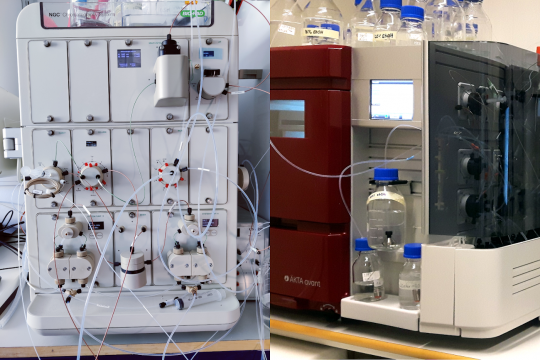Showdown: GE Healthcare's Äkta versus Bio-Rad's NGC

I have been purifying proteins since 1996. I worked on an Äkta Explorer until 2015, when we upgraded to the Äkta Avant. In 2020, my lab moved, and we inherited a Bio-Rad NGC, which we have been using now for 2 years.
We encountered many problems with the Bio-Rad NGC. At first, I thought that this might be normal when switching systems. I expected the problems to disappear one by one. After all, we also had problems when we switched from the Explorer to the Avant.
However, even after two years and dozens of purification runs, the problems with the NGC don't seem to stop. Whenever ẃe solve a problem, a new, previously unknown problem appears. And differently to GE Healthcare, Bio-Rad's customer service is not even close to what we have experienced with GE Healthcare. When our IT could not connect the Äkta to our university's network, GE Healthcare sent an engineer from their Munich crew to Helsinki to fix the problem. Appreciating the learning curve, GE Healthcare also offered free participation in one of their courses for somebody from our team. And their support was not limited to the warranty period! They really wanted us to be happy with their device. We don't experience the same amount of support from Bio-Rad. It always feels like we have to coerce them into solving the problems we have with the NGC, and their response time is well below any customer expectations.
This is the first of several blog posts about Äkta versus NGC. I hope will find the time to write in more detail about all our issues over the next few months.
We decided in 2015 that we finally needed a new FPLC. Our Äkta Explorer was reaching end-of-life, and we had received about 100k funding to renew the FPLC of our core facility. The device was expensive enough that we needed to go through the official tendering process (at the time, the limit was 30,000 €, but it has been increased to 60,000 € by now). There were only two contenders: The Bio-Rad Discover NGC and the GE Healthcare Äkta Avant. The Bio-Rad was cheaper (82,810 € versus 95,470 €), but we decided to purchase the GE Healthcare device. One important reason was that all our users had been using the Äkta Explorer and its Unicorn software. Switching would simply be disruptive and require lots of support and time from our side. However, there were also technical reasons that made us prefer the Äkta over the NGC:
Äkta Avant's advantages
- Refrigerated fraction collection
To "simulate" refrigerated fraction collection, we have placed the fraction collector for the NGC in a cold cabinet. It's a kludge. And the electronics (the cables) are not certified for that environment, and condense water makes the RJ-45 connectors oxidize. We have been fighting quite a bit with an unreliable connection of the fraction collector to the system. I am actually surprised that it took 10 years for these problems to develop, but now we have them. When the connection drops, we unplug and replug the cable a few times, and the system starts working again (after a reboot). - Better pumps
The Äkta pumps are simply better. They can generate much higher pressures. I doubt anybody needs higher flow rates than 25 ml/min, but high pressures can sometimes come in handy. - Wider dynamic range UV sensor
The dynamic range of the Äkta's UV monitor is almost twice as large as the one from Bio-Rad. As a matter of fact, we frequently exceed the dynamic range with our current Bio-Rad setup because of HIGH protein concentrations. Yes, you can change the UV cell, but nobody really wants to reconfigure the device on a constant basis. The NGC boasts the ability to measure simultaneously 4 wavelengths, while the Äkta does only three. So far, we have never needed more than three: 215, 280, and the color wavelength of a possible colored protein such as GFP. But if you do need four wavelengths, you might want the NGC, although you could feed the signal of an external sensor into the Äkta.
In hindsight, after two years of experience with the NGC, I am very happy that we chose the Äkta Avant in 2015 over the NGC. For every single component, Bio-Rad engineers apparently did choose the cheapest suppliers, while GE Healthcare mostly went with the industry standard. When comparing the quality/price ratio of these two machines, Bio-Rad suddenly becomes the more expensive choice. In the following blog posts, I will discuss a few of the issues that we encountered with the NGC, such as unstable UV sensor baseline, bad default choices, and missing software features. I never even knew that such problems existed even though our Äkta Explorer was >20 years old and did not receive nearly as much care as it should have, according to the maintenance manual. Stay tuned if you want to know what we went through with the Bio-Rad over the last two years! If you have questions about protein purification with an FPLC, feel free to contact me at michael@jeltsch.org!



